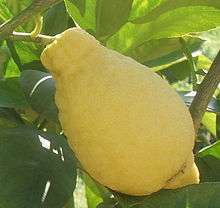Lumia (citrus)
| Lumia | |
|---|---|
 | |
| Species | Citrus × lumia Risso & Poit. |
| Cultivar | 'Lumia' |
The lumia (Citrus × limon var. 'Lumia', Citrus lumia Risso. & Poit., or Citrus aurantiifolia (Christm. et Panz.) Swingle var. lumia hort.[1]) is also called the pear lemon (Citrus × lumia 'pyriformis'), since its shape resembles a pear. It is also called French lime and sometimes sweet lemon, even though it is not necessarily sweet.

In German, the lumia is called Birnenlimone, Patriarch-Citrone, Süsse Limone[1] or Birnenlumie; in French it is called Poire du commandeur. In Chinese it is called Lu mi (露蜜), in Japanese Rumii (ル ミー), Vietnamese, Chanh Pháp.[1]
The fruit resembles a pear in shape, has a thick peel and is not very juicy. Like a citron, it can grow to a formidable size.
Pomum Adami
There is variety of Lumia called Pomme D'Adammo or Adam's apple, and is also included under the name Citrus lumia, according to Risso & Poit, the variety name is pomum adami. Pomme D'Adammo is genetically the same kind but in a rounded form.[2][3]
Origin and genetics

The most known origin for the Lumia is from the Mediterranean basin. The Lumia is also classified as Citrus limon var. lumia by Swingle which places it under the taxonomy of lemon, and Citrus medica L. var. lumia, that suggests it is similar to citron.
Usually the lumia is referred to as a citron hybrid, because of its size, thick peel and dryness of pulp. Pomo d'Adamo was also described by Johann Christoph Volkamer as a Cedrato which is Italian for a citron hybrid, whilst Cedro refers to a true citron.[4]
| Citron varieties |
|---|
| Acidic-pulp varieties |
| Non-acidic varieties |
| Pulpless varieties |
| Citron Hybrids |
| Related articles |
A group of scientists working in the University of Catania, Italy has shown by studying its chromosomes that the Pear lemon was first a hybrid of pomelo and citron, which then hybridized with regular lemon. In the website of University of California, Riverside they call it Citrus × limon L. Burm.f., noting conflicting reports about whether it is acidic or not, suggesting that it is a citron × lemon hybrid.[5]
A chromosomal study by researchers at the University of California found the lumia's DNA composed of pomelo, citron and sour orange DNA.[6]
Georges Gallesio has already reported that Pomme d'Adam is a hybrid with the orange.[7] Others are associating or confusing it with the limetta.[8]
The Following is from The Citrus Industry vol. 1 Chap.4:
| “ | Fruits Resembling the Citron. — There are numerous fruits in which citron characters are strongly pronounced. The lumias of the Mediterranean basin are natural hybrids in which acid citron or lemon and pummelo characters are evident. According to Chapot (1950a), they are characterized by fruits of large size, commonly somewhat pyriform, with highly acid flesh of greenish color, large purple-tinged flowers, and young shoot growth both pubescent and purple-tinted. Chapot states that the principal clonal varieties are "Poire du Commandeur", "Citron de Borneo" (Chapot, 1964d), and "Pomme d'Adam". They are of ancient and unknown origin, presumably Italian, and are grown only as curiosities or ornamentals.
The giant-fruited "Sui Khar" citron of Punjab State (Hodgson, Singh and Singh, 1963), the "Kabbad" citron of Damascus (Chapot, 1963f), and the "yemmakaipuli" of Coorg (India) also appear to fall in this group. |
” |
Medicine
According to a Japanese study of 1996, the albedo extract of the Lumia, was shown to possess the highest inhibitory activity against cyclooxygenase (IC50 = 24 μg/mL), among other citrus studied. Flavedo extract of ripe Lumia inhibited cyclooxygenase to the same degree as the albedo, more than the pulp extract.[9]
References
- 1 2 3 "MULTILINGUAL MULTISCRIPT PLANT NAME DATABASE – Sorting Citrus names part1". unimelb.edu.au.
- ↑ Jorma Koskinen and Sylvain Jousse. "Citrus Pages / Sitrussivut". free.fr.
- ↑ "Citrus pomum Adami = Citronier pomme d'Adam. [Adam's apple or Paradise apple]". NYPL Digital Collections.
- ↑ Nurembergishe Hesperidioum, Teil 3, Cap. 36
- For the illustration see here.
- ↑ Lumia lemon hybrid: Citrus × limon L. Burm.f., University of California, Riverside, retrieved 27 March 2016
- ↑ Barkley NA, et al. "Assessing genetic diversity and population structure in a citrus germplasm collection utilizing simple sequence repeat markers (SSRs).". nih.gov.
- ↑ "Traité du citrus. - Biodiversity Heritage Library". biodiversitylibrary.org.
- ↑ "CITRUS LIMETTA RISSO". unice.fr.
- ↑ Screening for Inhibitory Activity of Citrus Fruit Extracts against Platelet Cyclooxygenase and Lipoxygenase
Sources
- Citrus Pages
- Citrus Variety Collection website
- USDA page
- Zitrusgarten
- Agrumes Baches
- Tintory Citrus Plants
- Good Photo of Lumia